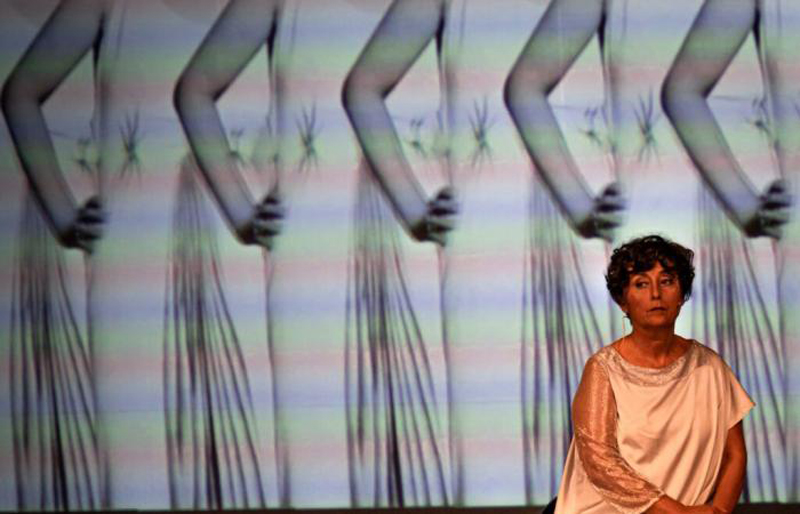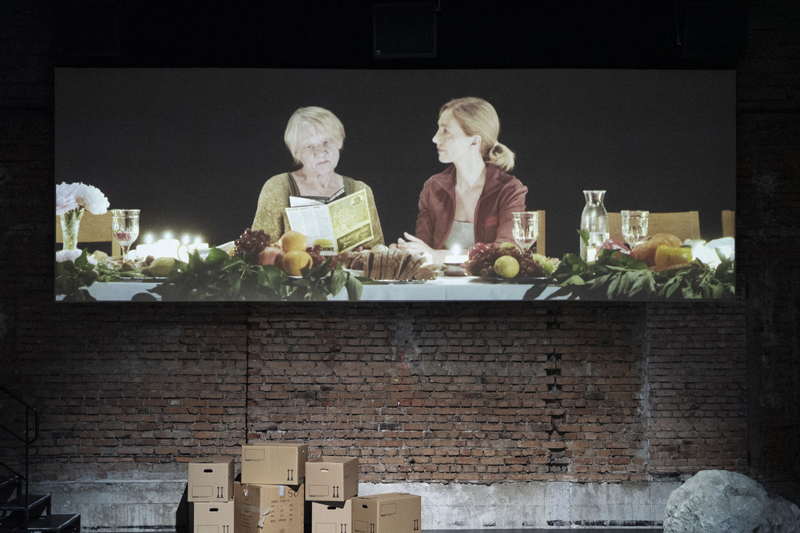Milan round-up
Margaret Rose in Milan
30 November 2021
Theatreland is once again bustling with companies scrambling to open productions, some of which have been nearly two years on standby due to the pandemic. While a minority of theatregoers are still anxious about returning to see plays, there is growing confidence now that masks and green passes are a must at all venues. In October and November I saw three plays that point to women’s increasingly more significant role in contemporary European theatre.

Maria Eugenia D’Aquino in An Evening with Schiap. Photo credit: Emma Terenzo.
The celebrated Motus company brought Tutto Brucia (Everything is Burning) to Milan’s Triennale Theatre. Motus was founded in Rimini in 1991 by Enrico Casagrande and Daniele Nicolò; their style is physical theatre and their productions are emotionally charged. Soon after the company was founded, they began touring nationally and internationally, stunning audiences with their audacious experimentalism. In Tutto Brucia, Nicolò and Casagrande, with the support of dramaturgs Ilenia Caleo and singer R.Y.F. (Francesca Morello), have created an audacious mix of the spoken word, dance, music, and song. The title of the work is suggestive: in 2021 we seem to be at the end of an era; in the wake of the pandemic, the world will never be the same again.
As in Motus’s previous show Antigone, classical theatre provides a lens to explore the present. In this case, Motus turned to Jean-Paul Sartre’s 1964 rewrite of Euripides’s The Trojan Women, an exploration of the themes of death and grieving in the wake of a horrendous war. Quotations, moreover, from Judith Butler, NoViolet Bulawayo, and Donna Haraway, woven into the rewrite, give the play a contemporary feminist feel. The action opens on a dark stage where several figures are huddled and wailing, therefore creating a soundscape conveying suffering, despair, and mourning. The war between the Greeks and Trojans is over, Troy has been destroyed and is still burning. The Trojan women have been turned into the pawns of war, their husbands and children slain, and they will soon be shipped abroad to unknown lands. The spoken word is continually juxtaposed with haunting music and songs performed in English by R.Y.F. (Francesca Morello), a well-known Italian singer, songwriter, and guitarist. Two performers, Silvia Calderoni and Stefania Tansini, invite us to focus on the women’s grief that is intensified by revulsion over their dead being buried with neither a suitable farewell nor a funeral.
On the one hand their words hark back to an ancient past, and on the other hand, they remind us of what we have experienced in recent times during two lockdowns and what many immigrants and their families have to face when their loved ones perish at sea. While the poetic dialogue is beautifully honed and delivered, the words of the songs are sometimes difficult to decipher, and so my understanding of the entire piece was hampered. Despite this, I felt myself sucked into the darkness that was loaded with despair and uncertainty while energized by the haunting rhythms of R.Y.F.’s music, which seemed to offer a ray of hope in an otherwise bleak panorama.

Maria Eugenia D’Aquino in An Evening with Schiap.
Photo credit: Elena Clara Savino.
In recent years the Pacta theatre has developed several noteworthy projects devoted to women and women’s rights and equality. Shocking Elsa, curated by Maria Eugenia D’Aquino, President and co-founder of Pacta, explores the work, talent, and world of celebrated fashion designer Elsa Schiaparelli (1890-1973).
This multifaceted programme includes the eponymous play (by Livia Castiglioni and directed by Alberto Oliva), a concert, and a fictive interview. I attended the latter, Una serata con Schiap (An Evening with Schiap), directed by Oliva and staged at Après-Coup, a welcoming restaurant-cum-theatre in the heart of Milan’s Porta Romana district. Leading journalist and fashion writer Antonio Mancinelli fired the questions while Schiaparelli, popularly known as Schiap and played by D’Aquino, kept an audience of about 40 enthralled by the tales of her work and private life. She mixed with painters including Salvador Dalí and Giorgio De Chirico and entertained a fraught friendship with Coco Chanel – whose lifestyle and dress designs were sober compared to Elsa’s more unconventional garments, some of them in shocking pink, the colour she invented and championed. D’Aquino’s rendition of Schiaparelli was superb, her gaze swiftly and constantly switching between Mancinelli and the audience seated in close proximity. She was sometime challenging and witty towards her interviewer, while her piercing and empathetic gaze made me as an audience member feel like her ally and confidante.

Everywoman.
Photo credit: Armin Smailovic.
Milo Rau’s Everywoman, a Berlin Schaubühne and Salzburg Festival production, opened the season of the Piccolo Teatro. Together with co-author Ursina Lardi, this internationally esteemed Swiss director has carried out what amounts to a highly innovative reworking of Hugo von Hoffmannsthal’s 1911 Jedermann (Everyman), derived from an early 1500s morality play, The Summoning of Everyman. Rau’s Everywoman is a two-hander; one character is onstage (Lardi) and the other (Helga Bedau) is in a video projection. It takes the central concept of Hoffmannsthal’s play, which is the dilemma of even a wealthy Everyman needing to die, and upturns it. Instead of Hoffmannsthal’s allegorical wealthy man, the two writers have created the character of an Everywoman who is dying – an ordinary person whose story is inspired by Helga Bedau’s real life story.
The play opens on Lardi alone, sitting on a chair, flanked by some everyday objects, books, and packing cases. Having turned on an old-fashioned tape recorder and speaking in Italian, she proceeds to tell the story of her life growing up in the Swiss Alps. Suddenly she switches to German as she concerns herself with a letter sent by an elderly woman (Bedau), terminally ill and whose last wish is to perform in a play. Bedau now appears on screen in close-up, allowing the audience to not only hear her voice but also to observe her tiniest facial movements – a flicker of an eye, and so forth. Paradoxically even though she is not onstage, we feel very close to her as she pours out her thoughts and feelings in this nearly final moment of her existence. Particularly interesting was the dialogue form: Lardi sometimes talks to Bedau and at other times she embodies her or talks about her. At a time when Covid-19 has put death and dying at the centre of all our lives, this play makes a timely in-depth exploration of the theme. I suggest you watch the YouTube interview that Caluio Longhi, director of the Piccolo Teatro, held with Milo Rau and Ursina Lardi when the play toured to Milan.





